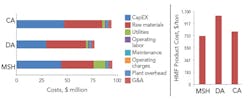Inorganic Salts Boost Sugar Extraction
A single-step process promises an economical way to produce soluble sugars at high yields from woody biomass, energy crops and agricultural residues, report researchers at the University of Delaware (UD), Newark, Del., and Rutgers University, Piscataway, N.J. The route relies on molten salt hydrates (MSHs). The inorganic-salts-based MSHs are easy to prepare, environmentally friendly, and less expensive than common ionic liquids, say the researchers.
Current approaches for separating sugars from the lignin in biomass require two steps: pretreatment involving either dilute acid (DA) or concentrated acid (CA) saccharification technologies, followed by lignin degradation with an enzyme. In contrast, the new process integrates the pretreatment and the hydrolysis of cellulose and hemicellulose in one pot. Moreover, the process operates at a lower temperature (85°C) and boasts a shorter reaction time (1 hr). This results in processing that is more energy- and water-efficient, claim the researchers.
Figure 1. Process based on molten salt hydrates offers an attractive alternative to dilute acid and concentrated acid saccharification technologies. Source: University of Delaware.
The key to the technology, for which UD has filed a patent application, is the use of a concentrated solution of an inorganic salt in the presence of a small amount of mineral acid. The solution swells the particles of biomass, enabling it to interact with the fibers.
The unique properties of the salt solution make the process very efficient, with up to a 95% theoretical yield of sugars, explains Basudeb Saha, associate director of research at UD’s Catalyst Center for Energy Innovation and leader of the research team.
[callToAction ]
The team integrated a dehydration reaction in the same pot to convert the sugars in the hydrolysate into furans such as hydroxymethylfurfural (HMF) and allow recycling the salt solution.
“Our process enables — for the first time — the economical production of feed streams that could profoundly improve the economics of cellulosic bioproducts manufactured downstream, not to mention the environmental benefits of replacing petroleum,” notes Saha. “We expect energy-efficient production of cellulosic sugars from our process will enable cellulosic biorefineries viability and provide sustainable supply of commodity sugars for downstream bioproducts production.”
A techno-economic analysis for an HMF plant to handle 400,000 mt/y of biomasss indicated the new process offers competitive capital and operating costs to DA and CA routes (Figure 1a). Moreover, simulation showed the MSH plant would produce more and higher-purity HMF than ones using the alternative processes — and thus would provide lower-cost product (Figure 1b).
More details appear in an article in ChemSusChem Communications.
“The next step includes process scale-up and sugars separation from the homogeneous hydrolysate,” says Saha.
“The key challenge at this time is the recovery of sugars from the hydrolysate… We are already working on the development of efficient separation technology for sugars recovery,” he adds.
Saha expects pilot-scale trials to start within 2 years.

